Decor
5 Stunning Topiary Decoration Ideas for Your Home
Add a touch of elegance to your home with these topiary decoration ideas that effortlessly elevate your decor and bring sophistication to any space.

Looking to spruce up your home with some greenery? Consider these topiary decoration ideas for a touch of elegance. The Grapevine Topiary Lamp combines coziness with innovative design. Vibrant Boxwood Centerpieces add pops of color and versatility. Festive Pumpkin Topiaries bring charm, perfect for Thanksgiving. Rustic Burlap Creations mix vintage materials with charm. Moss Topiaries offer an earthy and organic appeal, creating a calming ambiance. These ideas effortlessly elevate your home decor with sophistication and charm.
Key Takeaways
- Grapevine Topiary Lamp for cozy elegance.
- Vibrant Boxwood Centerpiece for colorful versatility.
- Festive Pumpkin Topiary for seasonal charm.
- Rustic Burlap Creation for vintage uniqueness.
- Moss Topiary Elegance for organic serenity.
Grapevine Topiary Lamp
When creating a cozy ambiance in a living space, consider incorporating a Grapevine Topiary Lamp for a unique touch of elegance and functionality. This innovative design focuses on the branch structure of topiaries while doubling as a lamp, providing a creative twist on traditional decor. The Grapevine Topiary Lamp offers a one-of-a-kind look, blending the natural beauty of grapevines with the practicality of lighting. Its originality shines through, making it a standout piece in any room.
The intricate branch structure of the Grapevine Topiary Lamp not only adds visual interest but also serves as a focal point, drawing attention to its unique design. The combination of lights woven within the grapevines creates a captivating display, perfect for enhancing the ambiance of a space.
Whether used as a decorative accent or as a functional lighting source, the Grapevine Topiary Lamp adds a touch of sophistication and originality to any home decor scheme.
Vibrant Boxwood Centerpiece

Boxwood topiaries, whether in live or artificial form, are a popular choice for creating vibrant centerpieces that add a pop of color to various room designs. These versatile decorations are perfect for sprucing up a coffee table or any other surface in need of a stylish focal point.
To enhance their aesthetic appeal, consider placing boxwood topiaries in rustic clay pots to add a touch of earthiness to your decor. Decorating with topiaries allows you to bring a bit of the outdoors inside, creating a fresh and elegant atmosphere in your living space.
Step-by-step guides are available to help you create stunning boxwood centerpieces that perfectly complement your room's color scheme and style. Whether you prefer a more traditional look or something modern and chic, boxwood topiaries can be tailored to suit your taste.
Festive Pumpkin Topiary
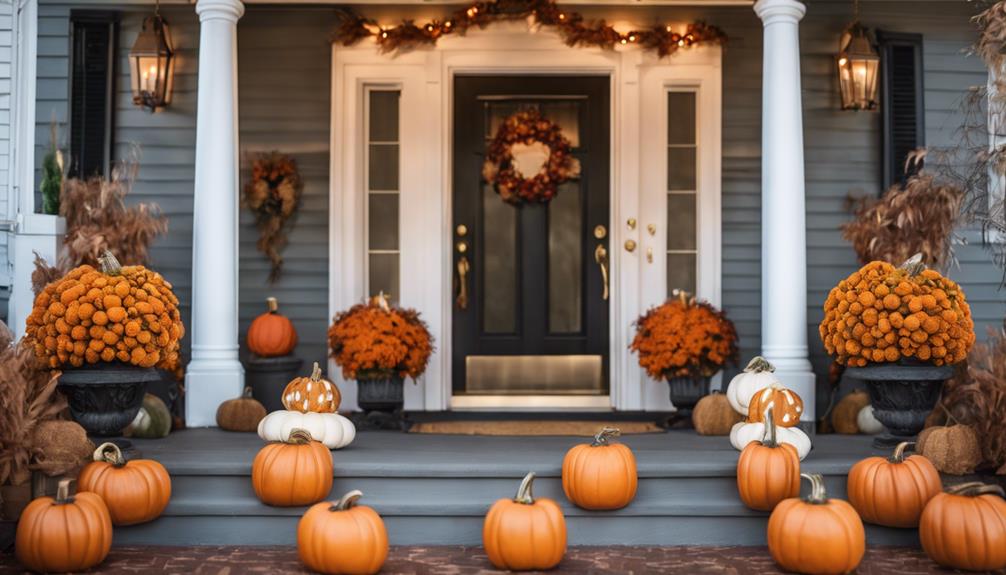
For a charming and festive touch to your seasonal decor, consider incorporating vibrant pumpkin topiaries. These topiaries, featuring white pumpkins and autumn colors, are perfect for Thanksgiving decor. They serve as excellent focal points on mantels or as centerpieces for holiday gatherings, adding warmth and charm to your home during the fall season.
DIY artificial pumpkin topiaries offer a creative and festive touch to your home decor, allowing for easy customization with different sizes and colors of pumpkins. Whether you prefer a traditional look with classic orange pumpkins or a more modern approach with white pumpkins, these topiaries are versatile and easy to adapt to your personal style.
Rustic Burlap Creation

Crafting rustic burlap topiaries allows for a unique and charming addition to your home decor. Here are some ideas to get you started:
- Visit Flea Markets: Scout flea markets for vintage burlap materials to give your topiaries a rustic feel.
- Use Beautiful Boxwood: Combine burlap with beautiful boxwood plants for a fresh green look that will stand out in any room.
- Create a Collection of Topiaries: Make a collection of burlap topiaries in varying sizes and shapes to create visual interest and depth in your decor.
- Personalize Your Designs: Customize your burlap topiaries to match your existing decor style by adding embellishments like ribbons or beads.
These steps will guide you through the process of creating stunning burlap topiaries that bring a touch of nature and creativity into your home.
Moss Topiary Elegance

Enhance your home decor with the natural and earthy elegance of moss topiaries. These unique decorations offer an organic aesthetic that brings a touch of nature indoors. Moss topiaries provide a bushy appearance, adding texture and depth to any room. Finished with a matching ribbon, they exude a cohesive and polished look, perfect for complementing the color scheme of your home.
Here is a table showcasing some key features of moss topiaries:
| Feature | Description |
|---|---|
| Aesthetic Appeal | Offers an earthy and organic vibe to home decor |
| Texture | Provides a bushy appearance with a natural feel |
| Color Palette | Complements the predominant colors in a room |
| Finishing Touch | Can be adorned with a matching ribbon for a cohesive look |
| Atmosphere | Creates a serene and calming ambiance in any space |
When considering a Home Tour, you will love the look that moss topiaries bring to your living space. You will be able to find these elegant decorations at various home decor stores, especially if you are looking for pieces that offer an organic and natural touch. Many interior designers especially love incorporating moss topiaries into their designs for the serene atmosphere they create.
Frequently Asked Questions
Are Topiaries Still in Style?
Topiaries remain a timeless decor choice, blending elegance and sophistication effortlessly. Their enduring popularity transcends trends, making them a classic staple in both traditional and modern design schemes.
The versatility of topiaries allows for various styling options to cater to diverse preferences. With their ability to add greenery and charm to any space, topiaries continue to be a favored choice for those seeking a touch of refined beauty in their homes.
How to Decorate With Topiary Balls?
When decorating with topiary balls, we must consider placement and styling. These versatile decor items can be displayed both indoors and outdoors, adding elegance to any space.
Whether hung from ceilings, placed in pots, or arranged on mantels, their various sizes cater to different design needs. Made from real plants like boxwood or artificial materials such as plastic or silk, topiary balls offer a sophisticated touch to any home.
What Makes a Good Topiary?
When evaluating a topiary, several factors contribute to its quality. A well-structured frame with defined shapes is crucial for a topiary's aesthetic appeal and longevity.
Utilizing high-quality materials, such as preserved boxwood or artificial foliage, guarantees durability and a realistic appearance.
The ideal topiary should complement the room's aesthetic and color scheme, providing versatility for styling in various locations within the home.
Unique features like lights or uncommon materials can add an original touch to home decor.
How Do You Make an Indoor Topiary?
When making an indoor topiary, select a suitable plant like rosemary, ivy, or boxwood for the topiary form. Use a wire frame or topiary form filled with sphagnum moss to shape the plant.
Regular pruning and shaping are essential to maintain the desired form indoors. Consider artificial topiaries for low-maintenance decor options.
Indoor topiaries bring elegance and greenery to any room in your home.
Conclusion
To sum up, these stunning topiary decoration ideas are sure to add a touch of elegance and charm to any home. From the Grapevine Topiary Lamp to the Festive Pumpkin Topiary, there's a unique creation for every style and taste.
So why not bring a little bit of nature indoors and transform your living space with these beautiful and eye-catching topiary decorations? Your home will become a botanical wonderland that will leave your guests in awe.
- About the Author
- Latest Posts
Introducing Ron, the home decor aficionado at ByRetreat, whose passion for creating beautiful and inviting spaces is at the heart of his work. With his deep knowledge of home decor and his innate sense of style, Ron brings a wealth of expertise and a keen eye for detail to the ByRetreat team.
Ron’s love for home decor goes beyond aesthetics; he understands that our surroundings play a significant role in our overall well-being and productivity. With this in mind, Ron is dedicated to transforming remote workspaces into havens of comfort, functionality, and beauty.
Mardi Gras Decoration
What Tradition Does Mardi Gras Celebrate?
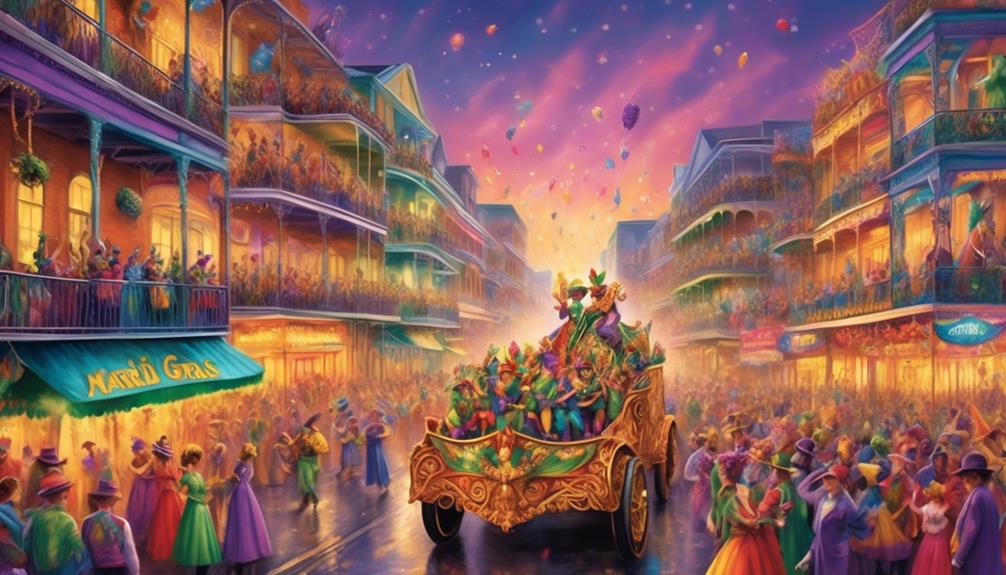
We have all heard of Mardi Gras, but do we really understand the tradition it commemorates? The bold colors, festive music, and extravagant costumes merge to create this legendary celebration.
But what lies at the heart of this centuries-old tradition? What deeper significance does Mardi Gras hold beyond the revelry and festivities?
Join us as we unravel the origins and customs of Mardi Gras, exploring its religious roots, the evolution of its customs, and the symbolism embedded in its festivities.
Key Takeaways
- Mardi Gras celebrates the origins and religious significance of the festival, which can be traced back to medieval Europe and ancient Roman pagan celebrations.
- The customs and symbolism of Mardi Gras have evolved over time, incorporating influences from various cultures. This includes the introduction of krewes, parades, extravagant costumes, masks symbolizing anonymity, and elaborate costumes representing diversity and creativity.
- Mardi Gras is celebrated in various countries around the world, showcasing cultural diversity and a collective spirit. The festival has a rich cultural and historical significance, extending beyond local traditions and influencing global celebrations.
- Symbolism is an integral part of Mardi Gras traditions, with vibrant colors, intricate designs, and traditional costumes paying homage to the original festivities in New Orleans. Mardi Gras also fosters unity among people worldwide, bringing together individuals from diverse cultures and promoting cultural exchange.
Origins of Mardi Gras
The origins of Mardi Gras can be traced back to medieval Europe, where it evolved from ancient Roman pagan celebrations. This festive tradition has a rich historical significance, deeply intertwined with cultural practices and beliefs. Historically, Mardi Gras, or Fat Tuesday, marked the last day of indulgence and feasting before the solemn season of Lent. The cultural significance of Mardi Gras lies in its ability to bring communities together in a celebration of life and abundance before the period of fasting and reflection.
The historical origins of Mardi Gras reveal a blend of religious and folk customs that have evolved over time. From the Roman Saturnalia to the Christian feasts of Epiphany and the pre-Lenten Carnival, Mardi Gras has absorbed a myriad of influences. These historical roots demonstrate the adaptive nature of the festival, reflecting the values and traditions of the societies that have embraced it.
Through the centuries, Mardi Gras has become a symbol of joy, resilience, and community spirit. This celebration continues to evolve, embodying the cultural diversity and collective spirit of the communities that partake in its festivities.
Religious Significance
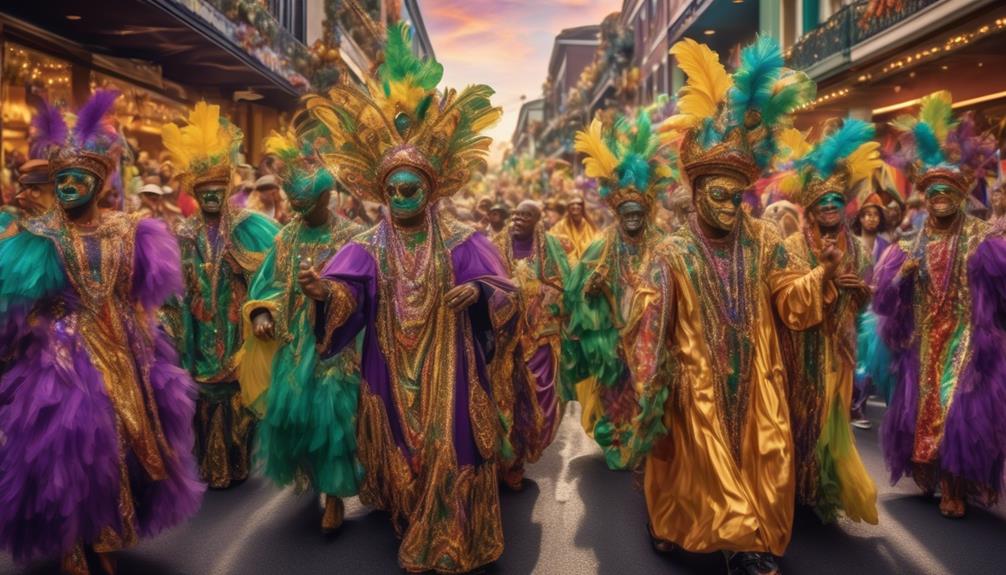
How does the historical evolution of Mardi Gras reflect its religious significance and impact on cultural practices and beliefs? Mardi Gras, with its origins in medieval Europe, has deep religious roots. It is intrinsically tied to the Christian liturgical calendar, specifically the period of Lent. The religious rituals associated with Mardi Gras, such as the lavish feasting and revelry, were meant to serve as a final celebration before the somber and penitential season of Lent. This religious significance has greatly impacted cultural practices, shaping the way Mardi Gras is celebrated and perceived.
| Religious Rituals | Cultural Significance | Impact on Beliefs |
|---|---|---|
| Shrove Tuesday, a day for confession and absolution | Mardi Gras parades, extravagant costumes, and feasting | Reinforcement of community bonds and celebration of life |
The religious rituals of Shrove Tuesday, with its focus on confession and absolution, have evolved into the Mardi Gras parades, extravagant costumes, and feasting. These cultural practices reinforce community bonds and celebrate the joy of life. The impact on beliefs is evident in the way Mardi Gras embodies the idea of embracing life's pleasures before a period of reflection and sacrifice.
Evolution of Customs
Exploring the historical progression of Mardi Gras customs reveals the dynamic adaptations and influences that have shaped this festive tradition over time. Mardi Gras has evolved through a rich tapestry of cultural influences, each leaving its unique imprint on the celebration. From the early French and Spanish settlers to the diverse African, Caribbean, and Native American communities, Mardi Gras has absorbed a myriad of customs and traditions, resulting in a vibrant and ever-changing tapestry of festivities.
The evolution of Mardi Gras customs also reflects modern interpretations of the celebration. While the religious and social significance remains, contemporary Mardi Gras has embraced new forms of expression and inclusivity. The introduction of krewes, elaborate parades, and extravagant costumes has added layers of spectacle and entertainment to the tradition, appealing to a wider audience while still retaining its cultural roots.
As Mardi Gras continues to evolve, it's crucial to recognize and appreciate the diverse influences and interpretations that have contributed to its current form. The customs and rituals surrounding Mardi Gras serve as a testament to the enduring nature of cultural traditions, continuously shaped by the people who partake in them.
Symbolism in Festivities

Throughout the vibrant and ever-changing tapestry of Mardi Gras festivities, symbolic representations play a pivotal role in conveying the rich cultural and historical significance of the celebration.
Symbolic costumes worn during Mardi Gras, such as the iconic masks, carry deep historical meanings. The masks, originally worn to escape social constraints and class distinctions, now symbolize the anonymity of revelers, allowing them to set aside their everyday identities and embrace the festive spirit without inhibition.
Moreover, the vibrant and elaborate costumes donned during Mardi Gras parades are symbolic of the celebration's roots in medieval European masquerade balls, where costumes were used to create a sense of equality and unity among participants. These costumes also serve as a visual representation of the diversity and creativity of the community, reflecting the individuality of each participant while collectively contributing to the visual spectacle of the parade.
The festive parades, with their colorful floats and lively music, symbolize the exuberance and joy of the community coming together to celebrate shared traditions and revel in the spirit of Mardi Gras.
The symbolism inherent in these facets of the festivities adds depth and significance to the celebration, connecting participants to the rich cultural heritage and historical evolution of Mardi Gras.
Global Celebrations
The symbolic representations in Mardi Gras festivities vividly reflect its rich cultural and historical significance, extending beyond local traditions to influence global celebrations. Mardi Gras has become a global phenomenon, with its cultural significance and festive parades celebrated in various parts of the world. The exuberant spirit of Mardi Gras has transcended borders, captivating people from diverse cultures who embrace the joyous atmosphere and lively street parties associated with the festival.
Traditional costumes, adorned with vibrant colors and intricate designs, are donned by participants in many global Mardi Gras celebrations, paying homage to the elaborate attire worn during the original festivities in New Orleans. The allure of Mardi Gras has led to the establishment of similar street parties and parades in cities worldwide, each infusing their unique cultural elements into the vibrant tapestry of the event.
As a result, Mardi Gras has evolved into a global celebration that fosters cultural exchange and unity, uniting people from different backgrounds in the spirit of revelry and merriment.
Frequently Asked Questions
How Does Mardi Gras Impact the Local Economy in New Orleans?
Mardi Gras significantly impacts the local economy in New Orleans. Local businesses experience a surge in revenue due to increased tourism during this festive season. The economic growth is fueled by the influx of visitors who contribute to the city's economy through spending on accommodations, food, and entertainment.
Community involvement is evident as residents and businesses actively participate in Mardi Gras, showcasing the cultural significance and historical traditions that further attract tourists and stimulate economic activity.
What Are Some of the Most Unique Mardi Gras Traditions in Different Regions Around the World?
Cultural variations in Mardi Gras traditions add vibrancy to the global celebration. Festive costumes reflect diverse customs and histories, with each region offering its unique flair.
From Brazil's samba parades to Venice's masquerade balls, the rich tapestry of Mardi Gras traditions showcases the beauty of cultural exchange. These customs underscore the universal appeal of revelry and community, uniting people across the world in joyous celebration.
How Do Different Cultures Incorporate Their Own Customs and Traditions Into Mardi Gras Celebrations?
When it comes to Mardi Gras, cultural integration is key to the diverse celebrations. Different cultures infuse their own customs into the festivities, creating a rich tapestry of traditions.
Festive costumes play a central role, reflecting the unique cultural influences. It's fascinating to see how various regions weave their heritage into the vibrant Mardi Gras celebrations, adding depth and diversity to the festivities.
Are There Any Environmental Concerns Associated With Mardi Gras Festivities?
Environmental impact of Mardi Gras festivities is a concern due to waste management issues. The cultural significance of the celebration often leads to large amounts of litter and plastic waste.
However, technological advancements in recycling and sustainability are being incorporated to mitigate these effects. Efforts to reduce the environmental impact include the use of biodegradable materials and increased awareness about responsible waste disposal.
These initiatives aim to preserve the traditions of Mardi Gras while minimizing its ecological footprint.
How Has Technology and Social Media Influenced the Way Mardi Gras Is Celebrated in Modern Times?
In modern times, the impact of social media and technological innovation has transformed the celebration of Mardi Gras. Virtual parades and online celebrations have allowed for remote participation, bringing the festivities to a wider audience.
Social media has amplified the reach of Mardi Gras, creating new ways for people to engage and share the experience. These changes have brought a sense of inclusivity and community to the traditions of Mardi Gras.
Conclusion
In conclusion, Mardi Gras is like a vibrant tapestry woven from the threads of history, religion, and culture. Its origins may be rooted in ancient pagan celebrations, but it has evolved into a global phenomenon that unites people in revelry and reflection.
The colorful customs and symbolism of Mardi Gras continue to fascinate and inspire, offering a glimpse into the rich tapestry of human traditions and the enduring spirit of celebration.
- About the Author
- Latest Posts
Introducing Ron, the home decor aficionado at ByRetreat, whose passion for creating beautiful and inviting spaces is at the heart of his work. With his deep knowledge of home decor and his innate sense of style, Ron brings a wealth of expertise and a keen eye for detail to the ByRetreat team.
Ron’s love for home decor goes beyond aesthetics; he understands that our surroundings play a significant role in our overall well-being and productivity. With this in mind, Ron is dedicated to transforming remote workspaces into havens of comfort, functionality, and beauty.
Architecture Home Styles
What Role Does an Architect Play in Society? A Guide
Marvel at the unseen influence architects wield in society, shaping our world with precision and purpose – discover the secrets architects hold in this insightful guide.

As we navigate our cities and spaces, the intricate dance between structures and society often goes unnoticed. Yet, what if I told you that architects are the silent choreographers, orchestrating this dance with precision and purpose?
The role of an architect in society is multifaceted, extending far beyond the mere construction of buildings. Join me as we unravel the layers of influence, innovation, and impact that architects wield in shaping the world around us.
Key Takeaways
- Architects blend creativity and practicality to shape innovative and functional environments.
- Architects preserve cultural heritage through conservation and adaptive reuse techniques.
- Sustainable architecture promotes a more environmentally conscious future through biophilic design and passive techniques.
- Architects advocate for inclusive, accessible spaces that prioritize diversity, equity, and social impact.
Architectural Design and Innovation
Architects play a pivotal role in society through their innovative designs, shaping the physical environment and reflecting the values of the communities they serve. Architecture goes beyond mere construction; it embodies a fusion of artistry and functionality. The essence of architectural design lies in the ability to transcend conventional boundaries and create structures that not only serve a purpose but also inspire and uplift. Architects are the visionaries who blend creativity with practicality to craft buildings that stand as testaments to human ingenuity.
In the realm of architecture, innovation is the cornerstone upon which progress is built. Architects continually push the boundaries of what's possible, employing cutting-edge technologies and sustainable practices to create spaces that aren't only visually striking but also environmentally conscious. Sustainable architecture, a growing trend in the field, showcases the commitment of architects to designing buildings that harmonize with their surroundings while minimizing their ecological footprint. Through their innovative approaches, architects not only shape the physical landscape but also pave the way for a more sustainable and aesthetically pleasing future.
Preservation of Cultural Heritage
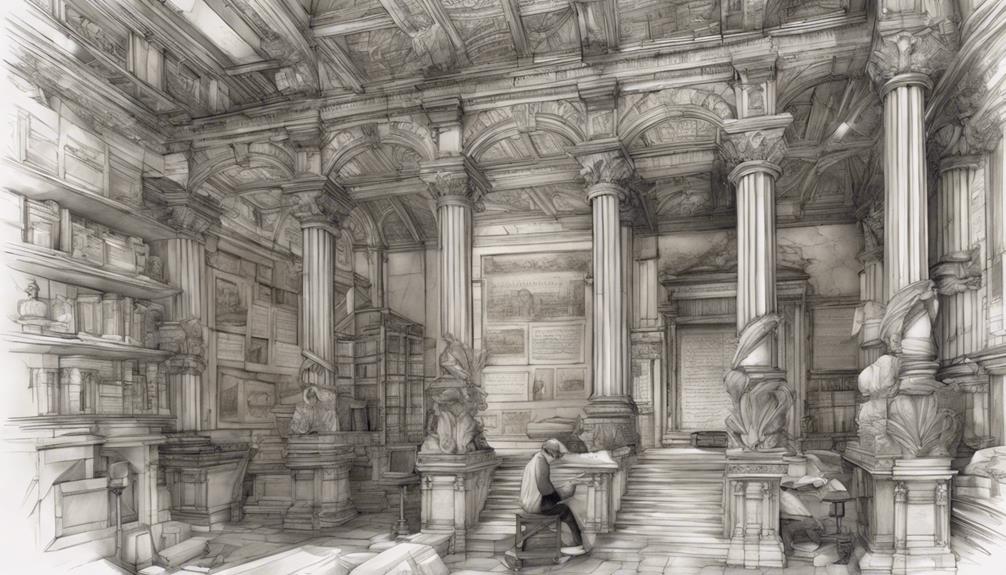
Preserving cultural heritage involves more than just restoring historical buildings; it requires a delicate balance between honoring the past and adapting to the present needs of society. Architects play a pivotal role in this process by employing architectural conservation techniques that respect the cultural backgrounds embedded in historical buildings. By utilizing traditional construction methods and materials, architects ensure the authenticity of heritage sites is preserved for future generations to appreciate. Additionally, through the concept of adaptive reuse, architects breathe new life into old structures while maintaining their historical integrity.
Architects engage in a careful dance between preservation and modern functionality, striving to create spaces that resonate with both the past and the present. This approach not only safeguards the historical significance and cultural value of buildings but also contributes to the enrichment of society by fostering a deeper connection to its heritage. By navigating this delicate balance, architects merge tradition with innovation, ensuring that cultural heritage remains a vibrant and integral part of our evolving urban landscapes.
Sustainable and Environmentally Conscious Practices
Implementing sustainable and environmentally conscious practices in architecture is crucial for addressing the pressing challenges of climate change and promoting a healthier planet. Sustainable architecture integrates principles like biophilic design and passive techniques to create buildings that not only reduce their environmental impact but also enhance the well-being of occupants. Biophilic design, which incorporates elements of nature into architectural spaces, has been shown to improve productivity, reduce stress, and foster a stronger connection to the environment.
By implementing passive techniques that maximize natural light and ventilation, architects can significantly decrease energy consumption in buildings, contributing to a more sustainable future. These architectural practices not only aim to meet current needs but also ensure that resources are preserved for future generations.
In the face of climate change, the role of architects in adopting sustainable and environmentally conscious practices is more critical than ever. Through innovative approaches to design and construction, architects have the power to combat climate change and create a positive impact on the planet.
Community Engagement and Social Impact
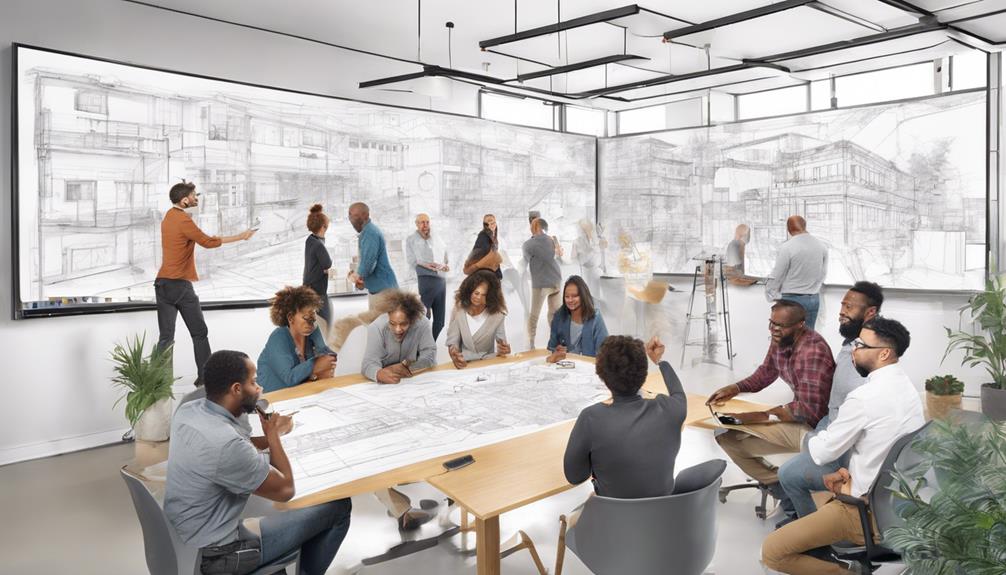
In exploring the intersection of sustainable architecture with community engagement and social impact, a holistic approach emerges that considers both environmental consciousness and societal well-being. Architects play a crucial role in fostering community engagement and driving social impact through their designs. By collaborating with local residents, stakeholders, and organizations, architects can create inclusive spaces that address local challenges and promote social well-being. This engagement ensures that architectural interventions aren't only aesthetically pleasing but also functionally beneficial to the communities they serve.
Social impact assessments allow architects to measure the effectiveness of their designs in positively influencing the lives of the people they impact. Through a deep understanding of the needs and aspirations of the community, architects can design spaces that enhance social cohesion, accessibility, and equity, ultimately contributing to a more sustainable and thriving society.
- Architects collaborate with local stakeholders to create socially impactful designs.
- Community engagement ensures that architectural interventions address local challenges.
- Social impact assessments help measure the positive influence of architectural designs on communities.
Advocacy for Inclusive and Accessible Spaces
Advocating for inclusive and accessible spaces in architecture involves prioritizing diverse human needs and abilities to ensure equitable and empowering environments.
Inclusive design transcends mere physical accessibility; it encompasses equity, safety, and cultural inclusivity. By embracing universal design principles, architects strive to create spaces that are functional and welcoming to all individuals.
This approach not only fosters a sense of belonging but also contributes to a more socially responsible and equitable society. Designing accessible spaces goes beyond accommodating disabilities; it aims to provide environments that are usable and beneficial for everyone, regardless of physical or cognitive differences.
Inclusive architecture plays a crucial role in shaping a built environment that reflects the values of diversity and inclusion. By advocating for accessible and inclusive spaces, architects champion the principles of equity and social responsibility, paving the way for a more inclusive and empowering society.
Frequently Asked Questions
What Is the Role of an Architect in a Society?
We envision dynamic spaces, shaping environments with a fusion of creativity and functionality. Architects craft structures that resonate with societal needs, influencing lifestyles and fostering community connections. Our collaborative efforts drive innovation and progress.
How Do Architects Contribute to Society?
We architects contribute to society by designing spaces that shape our everyday experiences and interactions. Our innovative designs enhance well-being, foster community connections, and inspire creativity. Through collaboration and vision, we create environments that enrich lives.
What Is the Role of Architecture in Modern Society?
In modern society, architecture serves as a dynamic reflection of societal needs and advancements, shaping our environment to accommodate evolving lifestyles and technologies. Architects blend creativity, innovation, and human-centric design to enhance our quality of life.
What Are the Social Responsibilities of an Architect?
We uphold social responsibilities through inclusive design, prioritizing sustainability, and fostering community engagement. Architects advocate for social equity, accessibility, and urban planning. Our role is pivotal in shaping environments that reflect societal values and address diverse needs.
Conclusion
As architects, we're the creators of spaces that shape our society, culture, and environment. Our designs not only reflect innovation and creativity but also serve as a bridge between the past and the future.
Through our commitment to sustainable practices, preservation of cultural heritage, and advocacy for inclusive spaces, we pave the way for a better tomorrow. The impact of our work goes beyond the physical structures, leaving a lasting legacy that enriches the lives of generations to come.
- About the Author
- Latest Posts
Introducing Ron, the home decor aficionado at ByRetreat, whose passion for creating beautiful and inviting spaces is at the heart of his work. With his deep knowledge of home decor and his innate sense of style, Ron brings a wealth of expertise and a keen eye for detail to the ByRetreat team.
Ron’s love for home decor goes beyond aesthetics; he understands that our surroundings play a significant role in our overall well-being and productivity. With this in mind, Ron is dedicated to transforming remote workspaces into havens of comfort, functionality, and beauty.
Architecture Home Styles
European Home Vs American Home: Contrasting Architectural Styles
A captivating exploration of the contrasting architectural styles between European and American homes will leave you intrigued and eager to discover more.
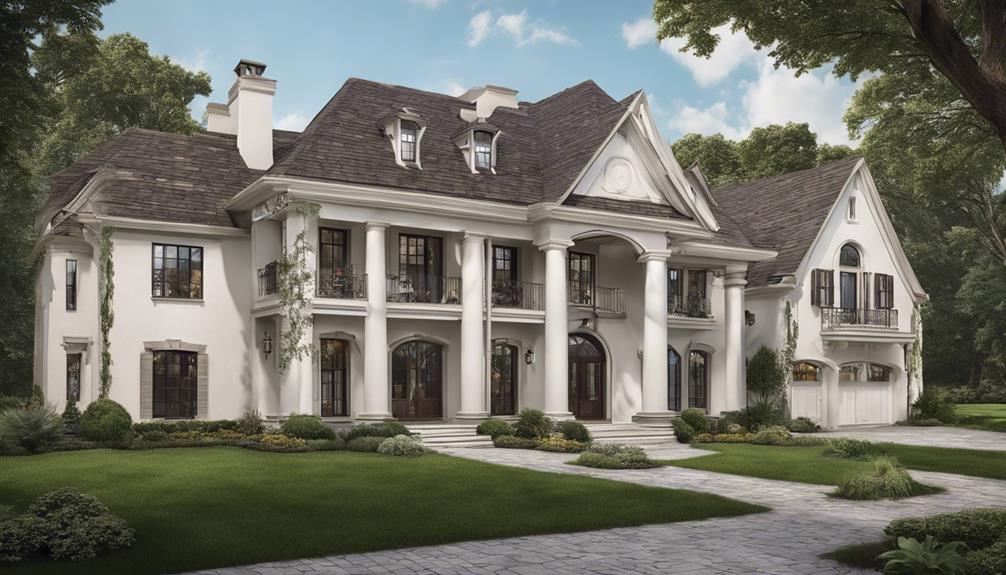
When strolling through the charming streets of Amsterdam, one cannot help but notice the quaint row houses with their unique gabled facades. These architectural marvels stand in stark contrast to the sprawling suburban homes found in the heart of America.
As we explore the differences between European and American home styles, we uncover a fascinating array of influences that shape the way we live and interact with our surroundings. From the materials used in construction to the layout of the interior spaces, each architectural choice tells a story of tradition and innovation, sparking a compelling dialogue on the essence of home design.
Key Takeaways
- European homes emphasize energy efficiency and communal living, while American homes prioritize traditional aesthetics and outdoor spaces.
- European homes feature compact designs with stone walls, wood roofs, and smaller plots, contrasting with American homes' larger dimensions and brick walls.
- European governments enforce strict regulations for energy-efficient homes, resulting in lower utility costs compared to less efficient American homes.
- Both European and American homes are adapting to modern lifestyle needs, blending open living spaces with traditional design elements for personalized living environments.
Property Size Differences
Comparing European and American home architectural styles reveals distinct differences in property sizes, reflecting cultural priorities and lifestyle preferences. American homes tend to be larger, often boasting multiple bedrooms and spacious yards, catering to the desire for ample living space and outdoor areas. In contrast, European homes are more compact and easier to maintain, typically featuring one or two bedrooms and smaller plots of land. This disparity in property size between American and European homes underscores the cultural variations in housing preferences.
American homes prioritize the accommodation of larger families with more bedrooms and bathrooms, while European homes emphasize efficient use of space with fewer rooms. The larger yards commonly found in American homes contrast with the smaller outdoor areas of European homes, illustrating the differing attitudes towards outdoor living and property maintenance. Ultimately, the property size variances between American and European homes highlight the importance of space and practicality in shaping architectural styles on both sides of the Atlantic.
Materials and Construction Variances

The choice of materials and construction techniques significantly distinguishes European and American home architectural styles, showcasing varying approaches to durability, aesthetics, and energy efficiency. European homes commonly utilize stone walls and wood roofs for insulation, emphasizing energy efficiency and a rustic charm. In contrast, American homes often feature brick walls and shingle roofs, providing a more traditional and classic appearance. Both European and American homes share a preference for granite kitchen countertops, while differing in flooring choices – European homes favor stone or marble floors for a touch of elegance, whereas American homes frequently opt for tile floors. However, wooden flooring is a common feature in both architectural styles, adding warmth and versatility to the interior spaces. European homes prioritize better insulation and energy efficiency through their construction materials and techniques, setting them apart in sustainable living practices.
| European Homes | American Homes |
|---|---|
| Stone walls, wood roofs | Brick walls, shingle roofs |
| Stone or marble flooring | Tile floors |
| Emphasis on energy efficiency | Traditional aesthetics |
| Rustic charm | Classic appearance |
Lifestyle and Cultural Influences
European homes, in contrast to American homes, often reflect a more communal lifestyle and cultural influence in their designs and layouts. This difference is evident in various aspects of the homes:
- Community Focus: European homes are designed to promote a sense of community living, with communal elements like parks and green spaces integrated into the neighborhoods.
- Isolation vs. Communal Living: American homes tend to prioritize isolationist designs, often found in gated communities, while European homes emphasize shared spaces and interactions among neighbors.
- Design Philosophy: European homes incorporate communal areas and green spaces into their design, encouraging social interactions and a sense of belonging within the community.
- Cultural Influences: The cultural emphasis on community and social connections in Europe influences the design of homes, fostering a more interconnected and social lifestyle compared to the more individualistic American approach.
These differences in design and lifestyle preferences between American and European homes highlight the cultural influences shaping architectural styles on both continents.
Energy Efficiency Contrasts

Prioritizing energy efficiency in home design, especially in insulation and sustainable practices, reveals a notable contrast between European and American architectural styles. Europeans prefer smaller, more compact homes that are inherently more energy-efficient due to better insulation standards. European governments have imposed strict regulations promoting energy efficiency in residential buildings, leading to reduced energy consumption and lower utility costs for homeowners.
In contrast, American homes, characterized by their larger dimensions and open layouts, tend to be less energy-efficient, resulting in higher energy consumption and utility bills. The emphasis on energy efficiency in European homes is evident in the meticulous attention to detail in insulation and sustainable design practices, reflecting a commitment to reducing environmental impact.
Floor Plans and Layout Disparities
In the realm of home design, distinctions in floor plans and layout preferences between European and American architectural styles are prominently showcased. When comparing European and American floor plans, several key differences emerge:
- Open Living Spaces: American homes typically feature open living spaces where the kitchen, living, and dining areas flow seamlessly into one another, promoting a sense of spaciousness and connectivity.
- Room Separation: In contrast, European homes traditionally favor separate rooms for specific functions, although there's a growing trend towards more open-plan designs to cater to modern lifestyle needs.
- Kitchen Designs: European kitchens are often compact and distinct spaces with frameless cabinets, while American kitchens tend to be larger, equipped with framed cabinets, and showcase bigger appliances, reflecting cultural nuances and preferences.
- Customization: Advanced design software like Foyr Neo allows homeowners to personalize their floor plans according to individual tastes, blending elements of both European and American styles to create a unique living space that suits their needs and aesthetic preferences.
Frequently Asked Questions
What Is the Difference Between American and European Architecture?
When comparing American and European architecture, we notice distinct differences.
While American homes often feature brick walls and shingle roofs, European architecture leans towards stone walls and wood roofs for better insulation.
Americans typically prefer open-floor plans, while Europeans opt for more compartmentalized living spaces.
Energy efficiency is a key focus in European homes, which are usually smaller and more sustainable.
These contrasting architectural styles reflect cultural preferences and design priorities.
What Is the Difference Between American Homes and European Homes?
When comparing American homes to European homes, we notice distinct differences in architectural styles, size preferences, and design priorities. Americans tend to favor larger homes with numerous bedrooms and bathrooms, whereas Europeans lean towards smaller, more efficient dwellings.
Energy efficiency and sustainability are emphasized in European homes through better insulation and eco-friendly design practices, contrasting with the spacious layouts and isolated living spaces commonly found in American homes.
What Is the Difference Between American Design and European Design?
When it comes to design, American and European styles diverge significantly. American design often prioritizes spaciousness and open layouts, while European design tends to favor compartmentalized rooms.
These differences in architectural philosophy are reflected in the materials used, energy efficiency standards, and overall aesthetic choices. Understanding these distinctions can provide valuable insights into the unique approaches each culture takes towards creating living spaces that suit their respective needs and values.
What Are the Characteristics of a European Style House?
European style houses often feature stone walls and wood roofs for insulation. These homes typically have smaller dimensions with one or two bedrooms and one bathroom. Granite worktops in kitchens and stone or marble flooring are commonly used.
European communities emphasize communal elements like parks and green spaces. Energy efficiency is a priority in European homes, with better insulation and sustainable design practices.
Conclusion
In conclusion, the contrasting architectural styles of European homes and American homes highlight the unique cultural preferences and design trends of each region. From property size differences to materials and construction variances, these homes reflect the values and lifestyles of their inhabitants.
But as we consider these differences, one question arises: how can we blend the best of both worlds to create a truly harmonious and sustainable living environment?
- About the Author
- Latest Posts
Introducing Ron, the home decor aficionado at ByRetreat, whose passion for creating beautiful and inviting spaces is at the heart of his work. With his deep knowledge of home decor and his innate sense of style, Ron brings a wealth of expertise and a keen eye for detail to the ByRetreat team.
Ron’s love for home decor goes beyond aesthetics; he understands that our surroundings play a significant role in our overall well-being and productivity. With this in mind, Ron is dedicated to transforming remote workspaces into havens of comfort, functionality, and beauty.
-

 Vetted3 weeks ago
Vetted3 weeks ago15 Best Contact Paper for Kitchen Cabinets to Elevate Your Home Decor
-

 Vetted1 week ago
Vetted1 week ago15 Best Poe Cameras for Home Security – Reviews & Buying Guide
-

 Vetted4 weeks ago
Vetted4 weeks ago15 Best Leather Restorer Products to Revive Your Furniture and Accessories
-

 Vetted3 weeks ago
Vetted3 weeks ago15 Best Drain Snakes to Unclog Your Pipes Like a Pro
-

 Beginners Guides2 days ago
Beginners Guides2 days agoI Inhaled Vinegar Fumes
-

 Vetted3 weeks ago
Vetted3 weeks ago14 Best Stationery Brands for Your Next Writing Adventure
-

 Beginners Guides2 weeks ago
Beginners Guides2 weeks agoSwinger Porch Light Color
-

 Mardi Gras Decoration3 weeks ago
Mardi Gras Decoration3 weeks agoWhy Does Hobby Lobby Not Do Mardi Gras?

























